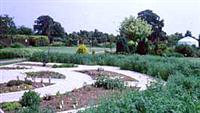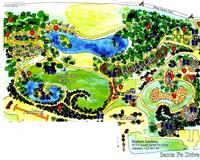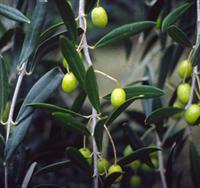Study Permaculture and Horticulture in this intensive certificate
Learn about the principles of permaculture and the fundamentals of horticulture.
 Gain an important broad-based understanding of horticulture which greatly improves your ability to design effective permaculture systems.
Gain an important broad-based understanding of horticulture which greatly improves your ability to design effective permaculture systems.- Learn about plant nomenclature and taxonomy, the plant kingdom, genus, species, and hybrids.
- Learn about plant culture - planting, pruning, irrigation.
- Learn about soil classification.
- Learn about plant nutrition.
- Learn principles of good horticultural practice.
- Learn about the principles of permaculture.
- Develop an understanding of the interraction of the different elements in a permaculture system - plants, animals.
- Develop your knowledge of permaculture techniques; learn about zones and sector planning.
- Learn about developing permaculture systems for different environments and climates.
- Understand more about designing, planning and costing the development of permaculture systems.
- Choose from a selection of Elective Modules to focus part of your qualification on a specialist area of your choice.
Improve your career prospects
These studies also broaden the employment prospects of graduates enabling them to seek employment in areas such as nurseries, landscaping and garden management. You will not only know about Permaculture systems, you will know how to integrate the two together, making you a valuable consultant to the Horticulture industry.

Graduates may find employment in either general horticulture, or in areas servicing permaculture or natural gardening (e.g. garden/system design, plant nurseries, teaching, consulting, etc.). Half of the course provides detailed training in Permaculture whilst the other half provides a broad, general foundation in horticultural practices. This course was compiled to cover all components of the Permaculture Institute's Permaculture Design Certificate curriculum (the equivalent of 72 hours of study).
Graduates of this course are awarded PERMACULTURE DESIGN CERTIFICATE by their tutor (as is normal practice in the permaculture industry).
COURSE STRUCTURE AND CONTENT
The course is divided into three areas, consisting of:
- The CORE UNITS common to all streams of the Certificate in Horticulture comprise of 15 lessons. These studies will enable you to develop broad general skills in horticultural practices and plant knowledge. All students undertaking this certificate will complete these units. The core units comprise approximately 50% of the course content. Further details of the lessons are shown below.
- The STREAM UNITS which form part of the specialised studies for the Certificate in Horticulture (Permaculture) comprising two Permaculture units: Permaculture Systems; Advanced Permaculture;
- An ELECTIVE UNIT. Students are to select a module relevant to studies in Permaculture (which must be approved by the School), for example: Poultry, Aquaculture, Herb Culture, Berry Production, Fruit Production, Self Sufficiency I
Enrolment fees do not include exam fees. (You need to sit 2 exams for the core, and one for each of the stream modules = 5 in total).
CORE STUDIES
Lesson 1. Introduction to Plants
- Nomenclature and taxonomy,
- The plant kingdom,
- Genus, species, hybrids.
Lesson 2. Parts of the Plant
- How plants grow, plant structure,
- Parts of the flower and leaf,
- Modification of stems and roots.
Lesson 3. Plant Culture - Planting
- How to plant and protect newly planted specimens,
- Annuals, biennials, perennials, deciduous, evergreen and herbaceous plants.
Lesson 4. Plant Culture - Pruning
- Purpose for pruning,
- Rules for pruning,
- How to prune.
Lesson 5. Plant Culture - Irrigation and Machinery
- Different irrigation systems,
- Components of an irrigation system,
- Use and maintenance of machinery and tools.
Lesson 6. Soils and Media
- Soil classifications,
- Testing soil,
- Potting mixes,
- The U.C. System, ingredients of potting mixes.
Lesson 7. Soils and Nutrition
- Fertilisers
- Deficiencies and toxicities,
- N:P:K ratios,
- Salting,
- Fertiliser programming,
- Compost.
Lesson 8. Propagation - Seeds and Cuttings
- How to propagate plants by seed and cuttings,
- Propagating mixes,
- Cold frame construction,
- After care for young plants.
Lesson 9. Propagation - Other Techniques
- Other methods to increase plant numbers
- Budding, grafting, layering, division and tissue culture.
Lesson 10. Identification and Use of Plants - Landscape Application
- How are plants used in the landscape,
- How to choose and purchase plants,
- Selecting plants suitable for the climate and site.
Lesson 11. Identification and Use of Plants - Problems
- Problems with plants
- Choosing plants for problem sites.
Lesson 12. Identification and Use of Plants - Indoor/tropical Plants
- Indoor and tropical plants, flowers, herbs, bulbs, ferns.
Lesson 13. Pests
- Identifying and controlling pests,
- Chemical and natural methods for control,
- Chemical safety precautions.
Lesson 14. Diseases
- Identifying and controlling diseases,
- Plant pathology,
- Fungi, viruses, non-pathogenic problems,
- Interactions with the host and the environment.
Lesson 15. Weeds
- Identifying and controlling weeds,
- Chemical terminology.
STREAM STUDIES (PERMACULTURE)
The course is divided into eight lessons as follows; further information on the module can be accessed by following the link in the title:
- Permaculture Principles
- Natural Systems
- Zone & Sector Planning
- Permaculture Techniques
- Animals in Permaculture
- Plants in Permaculture
- Appropriate Technologies
- Preparing a Plan
Each lesson culminates in an assignment which is submitted, marked and returned with any relevant suggestions, comments, and if necessary, extra reading.

Module Aims include:
- To apply the principles of permaculture.
- To demonstrate knowledge of the concepts of natural systems.
- To apply permaculture techniques - involving zones and sector planning.
- To use a range of permaculture techniques: (forest plantings, mandala gardens, etc).
There are ten lessons in this module as follows; further information on the module can be accessed by following the link in the title:
- Evaluating Design Strategies
- Understanding Patterns
- Water
- Earthworks
- Humid Tropics
- Dry Climates
- Temperate to Cold Climates
- Planning Work
- Costing
- Sustainable Systems
Module Aims include:
- Evaluate appropriate design strategies for a specific development site.
- Explain the relationship between a Permaculture system and natural patterns occurring in your local area.
- Develop strategies for the management of water in a Permaculture design.
- Determine earthworks for the development of a Permaculture system.
- Design a Permaculture system for the humid tropics.
- Design a Permaculture system for a dry climate.
- Design a Permaculture system for a temperate to cold climate.
- Determine planning strategies for the development of a Permaculture system.
- Prepare cost estimates for a Permaculture development plan.
- Explain alternative sustainable systems practiced in various places around the world.
ELECTIVE MODULE (PERMACULTURE)

Following completion of the Permaculture Systems and Advanced Permaculture modules, you then choose one 100 hour module, from a wide range of options including the following those listed below. The module must be relevant to the Certificate, and must be approved by the School.
Upon successful completion of the course and exams, you will be awarded a Permaculture Design Certificate by our tutor and a Certificate in Horticulture (Permaculture).
Biodiversity is a Core Principle
By learning to create ecosystems that have a rich variety of flora and fauna, you will greatly improve your chances of creating stable and sustainable landscapes. one principle of permaculture is diversity. In a permaculture system you should grow a variety of different plants together. This ensures greater biological stability. For example, using beans in permaculture helps fulfil this important principle because beans have multiple functions – they help improve soil fertility and can also be harvested for food.
The size, shape, density, arrangement and diversity of plants influences:
- Temperature - plants make air and soil temperatures cooler in summer and warmer in winter.
- Water - soil is less likely to dry out under a tree canopy.
- Wind - direction can be changed, strength can be reduced.
- Deciduous trees - lose their leaves in winter creating different environmental effects across seasons.
- Frost - there is far less chance of frost alongside other plants, or under the canopy of plants.
Techniques Often Used in Permaculture
One way to plan a permaculture system involves seeing it as a series of zones which each have specific characteristics and purposes. The zones might be thought of as concentric rings radiating out from a home or from a central pathway through the permaculture system.
Components that need to be accessed most often (e.g. vegetables, chickens, nut trees) are in Zone 1 and are located closer to a central Zone 0 (e.g. a home and any buildings associated with the house). They are located further away if they are accessed less often e.g. Zone 3 may be the fruit trees and Zone 4 may be the woodlot and be farthest away from Zone 0 because it is not often used. However, zones should be flexible and flow into each other.
Permaculture design also uses sectors. Sector planning aims to channel external energies such as wind, fire, sun and flood in a desirable direction. Good design will protect property from bushfire, strong winds, flood or extreme heat if these factors are potential problems. In a cold climate, the same considerations will ensure that the sun's energy is caught and used where and when it is needed. In a dry climate, limited rainfall must also be caught and used to maximum benefit.
Concepts such as sectors are far more site-specific than the conceptual ideas of zones. Sectors are identified by existing factors that affect the property such as winds, sun direction, good or poor views, access, water sources, and the like.
Edges
As in natural forests there should be areas without large trees in a permaculture system.
The "edge" between a treed and non-treed area will be a different environment again to the areas with and without trees. These "edges" provide conditions for growing things which won't grow fully in the open or under the canopy of trees. The southern edge of a treed area (in the northern hemisphere) is sunny but sheltered while the northern edge is cold but still sheltered, more than in the open.
Pioneer plants are used initially in a permaculture system to provide vegetation and aid the development of other plants which take much longer to establish. These pioneer plants are often short-lived. For example, legumes grow fast and fix nitrogen (raise nitrogen levels) in the soil which increases the nutrients available to nut trees growing beside them. Over time the nuts will become firmly established and the legumes will die out.
Develop Horticultural Knowledge, Embrace Principles of Permaculture
Studying the Certificate In Horticulture (Permaculture) will provide students with a good knowledge of horticultural fundamentals. The Permaculture studies will provide added understanding of the relationships between different natural components and the ability to approach projects with an eye on sustainability.
The knowledge that students develop in the course will be of benefit to those seeking or working in general horticulture, or in nurseries, or public parks, or for those looking to build careers in areas such as natural garden design, or consulting.
As climate change and our environment become ever more serious and pressing considerations, studies in permaculture have never been so prescient.
You can enrol on the Certificate In Horticulture (Permaculture) at any time. It is studied by distance learning. Our highly knowledgeable and experienced tutors are on hand to provide guidance and support throughout your studies; whilst practical elements that form part of the qualification will provide students with the opportunity to practice what they learn and gain a greater understanding of what they are studying.
If you should have any questions about the course, or want to know more, please get in touch with our specialist Horticulture and Permaculture tutors today. They will be happy to answer your questions, and discuss the study options available that fit in with your goals.